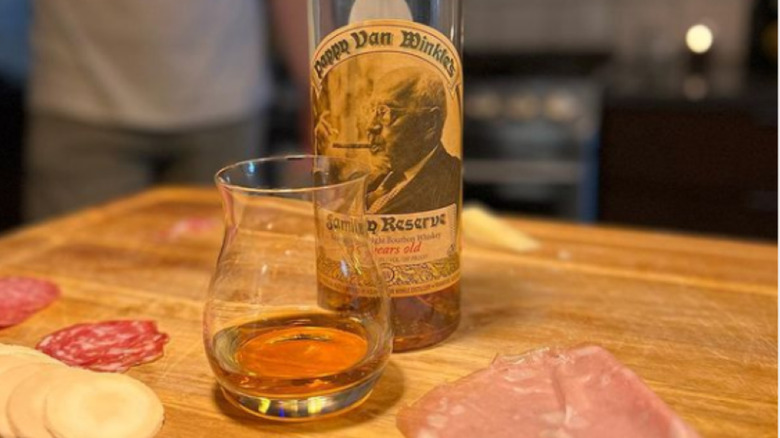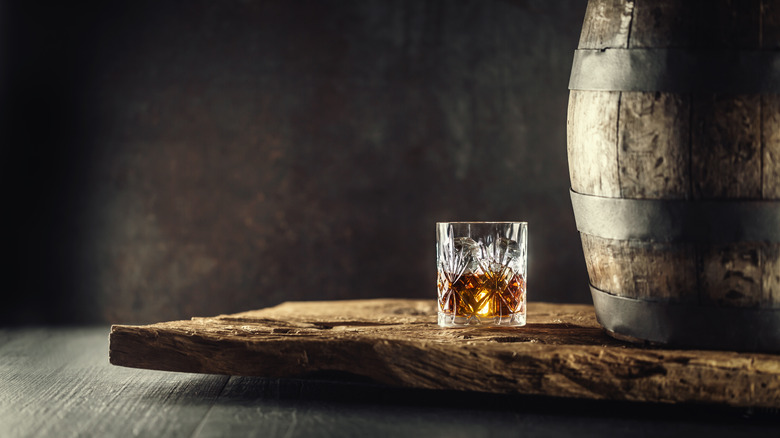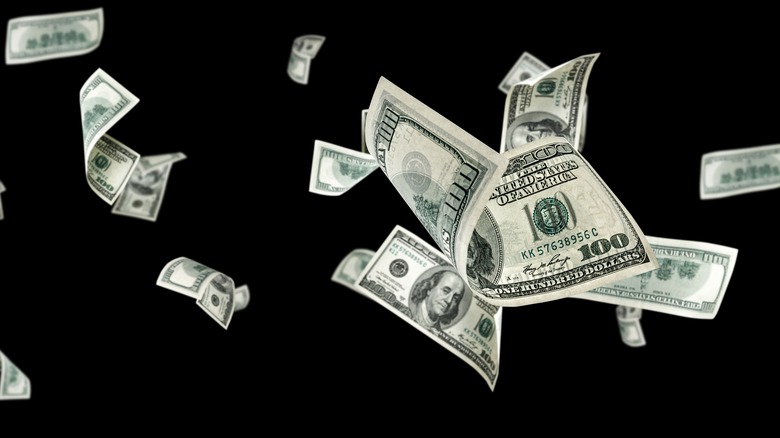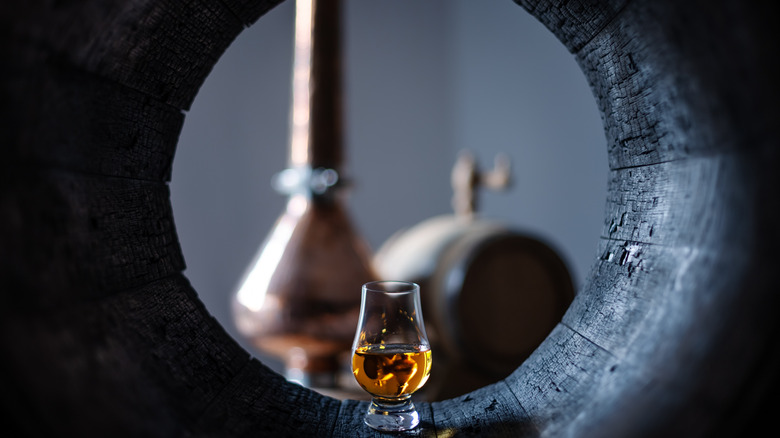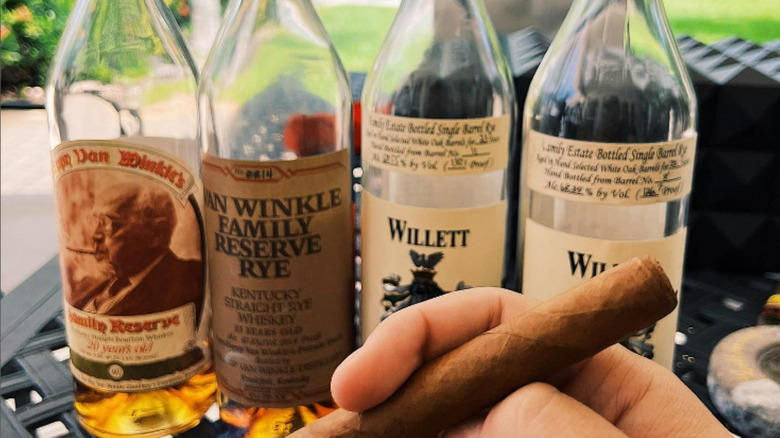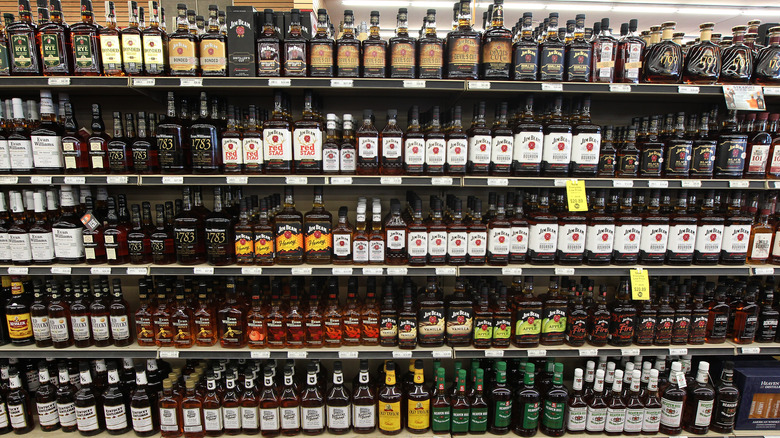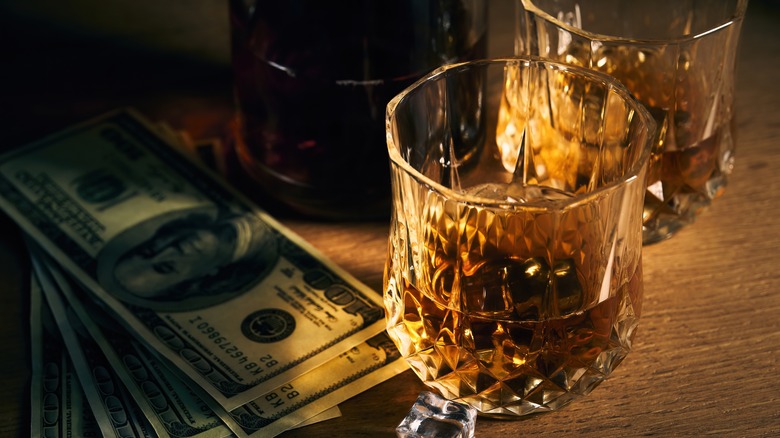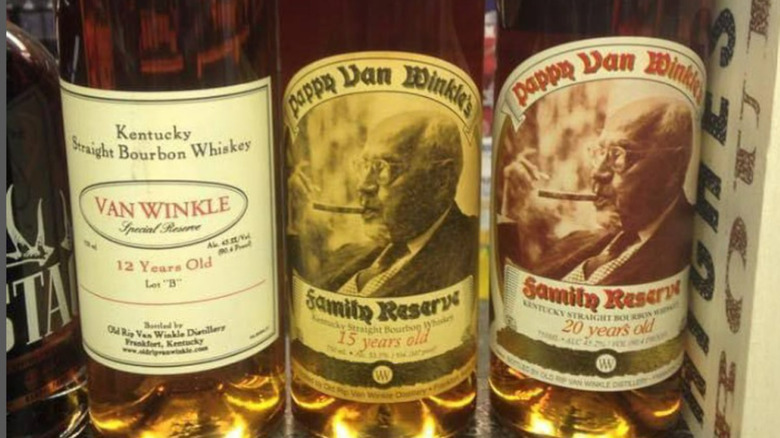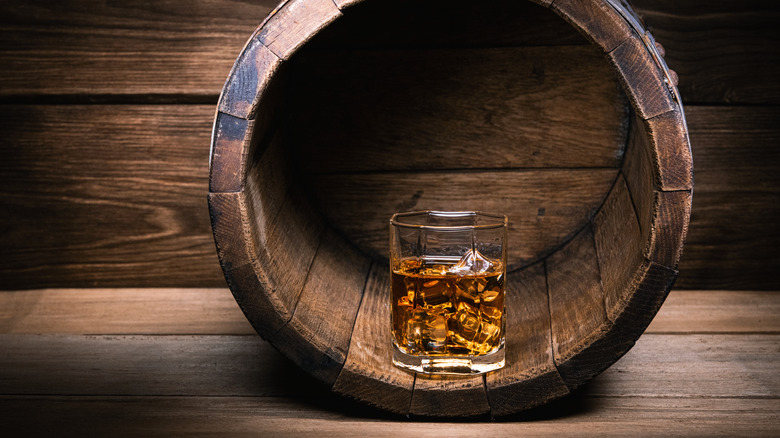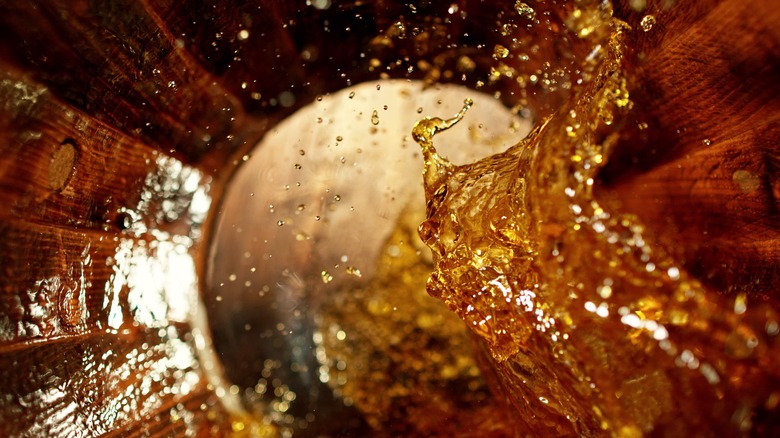Pappy Van Winkle 23: The Ultimate Bottle Guide
Decades ago, the "menfolk" drank bourbon in dark bars and back rooms while puffing on fine cigars (smoking jacket optional). That's no longer the case. Bourbon is being poured like it's putting out a wildfire, and both men and women are indulging. According to Kentucky.com, the Bluegrass state filled 2.6 million barrels of bourbon in 2021, while 11.4 million barrels of bourbon sat aging. To be clear, bourbon is a Kentucky thing. Until very recently, you couldn't legally use the name "bourbon" on a bottle of whiskey, even if it was made exactly as a bourbon should be, unless it hailed from Kentucky. Now, the laws have changed, and you'll find bourbon in other places, but there will always be purists who won't touch it.
Drinking bourbon has become a hobby for many and it includes tastings, sharing with other enthusiasts, and, best of all, hunting for hard-to-find bottles. If there is one label every bourbon aficionado longs for, it's Pappy Van Winkle 23. It's considered one of the rarest bourbons in the world, and it's not easy to get your hands on it. Pappy has a long history in the whiskey world and plenty of devoted fans who hope to be the next lucky lottery winner of the Family Reserve.
The history of Pappy Van Winkle
Such an unusual name begs the question, was Pappy Van Winkle a real person? Yes indeed, he was. Buffalo Trace distillery writes that Julian P. "Pappy" Van Winkle, Sr., along with his friend Alex Farnsley, purchased two companies back in the 1800s: W.L. Weller and Son's wholesale house in Louisville, as well as the A. P.h. Stitzel Distillery. The two were merged and Stitzel-Weller was born.
The distillery was eventually sold by Pappy's son in 1972. They sold off all the rights to the labels except for one — Old Rip Van Winkle, a label that hadn't been seen since before prohibition. Stock from the old distillery was used for the resurrected label, and today, four generations later, the Van Winkles are carrying on the tradition of fine bourbon. You can find them at the Buffalo Trace distillery in Frankfort, Kentucky, where they recently began a new venture with the established names of Van Winkle and Buffalo Trace, and continue to use the same, strict guidelines passed down from Pappy.
Why is Pappy Van Winkle 23 so expensive?
In your local liquor store, you'll pay anywhere from $20 to $200, and sometimes even more for a bottle of bourbon. Is expensive always better? Some say to drink what you like — the cost doesn't matter. Others say the opposite. The Bourbon Culture writes that higher-priced bourbon tastes so much better that whether you are a regular bourbon drinker, enjoying a blind taste test, or sipping a glass for the first time, you'll know you are drinking something special.
That brings us to the question of why is Pappy Van Winkle 23 so expensive. Enthusiasts agree — it's just that good. Max Liquor explains that because each year, as the bourbon ages, it passes through another layer of flavor in the oak barrels, Pappy 23 results in one of the rarest, most fulfilling bourbons you can find. There's also the issue of supply and demand that raises the price of a bottle.
Basically, there is a high demand for Pappy Van Winkle 23 and a low supply. Here's the thing — Pappy Van Winkle 23 gets the number 23 because that's how many years it is aged. It's not like a bourbon that is distilled a few years and bottled up. According to Whisky Shop, only 84,000 bottles of this rare bourbon are released each year. Compare that to a lower-cost whiskey, such as Jim Beam, which releases 84,000,000 bottles each year, and it puts it in perspective. Many of us will never see, let alone taste, a bottle of Pappy Van Winkle 23.
How Pappy is distilled
When it comes to making bourbon, the methods used are everything. Distilling is the process of bringing the bourbon to fruition, and how it's done truly matters. It's important to understand that bourbon is a whiskey, as is Scotch (and everything else labeled as whiskey). What makes each one different is how they are made, including the mash (the grain choices), proofing methods, barrels used, where they are distilled, and the aging process.
To be a bourbon, the mash must be at least 51% corn, per New Riff Distilling. Pappy 23 starts by going through the usual bourbon-making process of mashing, fermentation, straining, distilling, and aging (via MasterClass). However, Pappy Van Winkle has a secret to their rare flavor. As mentioned, bourbon requires the mash to be 51% corn, and after that, rye is usually added to a bourbon mash for flavor. But Pappy Van Winkle, in his infinite wisdom, uses wheat in the mash instead of rye, giving it a unique taste when compared to other bourbons, according to Vine Pair. That's how Pappy Van Winkle is made. What makes Pappy 23 specifically rare is how long the aging process lasts. After the long distilling process, Pappy Van Winkle is put to rest in an oak barrel for more than two decades and emerges as the highly sought-after Pappy Van Winkle 23.
The notes in 23
Notes refer to the tastes, aromas, and final finish of a drink. There are several common notes in most bourbons, including wood, vanilla, fruit, smoke, and spices such as cinnamon or cloves. Each bourbon may lean heavily toward one of the common notes or have an interesting mix as you taste one flavor, but then smell another, and yet another as you swallow.
Because Pappy Van Winkle 23 is made with wheat rather than rye, it's already unique compared to other bourbons. Couple that with the fact that it's aged in oak barrels for 23 years, and you've got a unique bourbon with notes you may not taste anywhere else.
The first part of identifying notes is with your sense of smell. It's helpful to bring the glass to your nose and breathe in the bourbon to identify aromas. According to The Whiskey Wash, when it comes to the nose, Pappy 23 carries notes of chocolate, tobacco, and prunes. It also is a bit earthy and even has a hint of the forest floor. Notes sometimes change or are enhanced with a drop or two of water in the bourbon. When water is added to Pappy 23, it brings out vanilla, plum, pine, cherry, and apricot custard, while still allowing the earthiness to flow through. On the palate, Buffalo Trace Distillery writes that you'll taste vanilla, honey, maple, and citrus, followed by a finish of oak and the previous earthy notes. Wow — anyone for a glass of bourbon?
How to find a bottle of Pappy 23
How to find a bottle of Pappy Van Winkle 23 is the question all bourbon enthusiasts ask. The answer is good luck. Truthfully, if you seriously want a bottle and are willing to spend the money, there is one way to try to score one. Before diving into that, though, it's important to point out that you shouldn't buy a bottle from an unknown source online. There are dangerous counterfeits out there. Mark Brown, the president and chief executive officer of Buffalo Trace distillery, told Lexgo Eat that not uncommon for people in other countries to buy from unlicensed retailers and pay the price with their health. So, avoid private sellers and stick with licensed retailers.
The best chance at getting a bottle of Pappy is through an official Pappy Van Winkle lottery with a licensed retailer. The lotteries sell the bottles at the MSRP (manufacturer's suggested retail price). According to Old Rip Van Winkle Distillery, Pappy Van Winkle 23 hits the retailers' shelves anywhere from October to December each year, after the wholesalers receive it. From there, the retailers can decide how they want to sell it, and it's usually through a lottery or waiting list. If you're interested, it's best to ask around at liquor stores to see if they'll receive some stock and then see how they'll be selling it.
A bottle once sold for $52,500
Now that you know how rare it is and what the layers of notes are in Pappy Van Winkle 23, how much would you be willing to fork over for one of these nearly impossible-to-find bottles? A thousand dollars? Two thousand? The suggested retail is $300, according to Old Rip Van Winkle Distillery, though they often fly off the shelves or go from one hand to another for much more than that.
Once in a while, there is an auction that may have a bottle of Pappy 23, and at those times, the sky is the limit for what it might sell for. In one case, at an auction at Sotheby's in New York, a person paid $52,500 for one bottle (via the Robb Report). Let's hope they enjoyed it. Sure, for that price you could buy a new car, but Pappy Van Winkle 23 only comes around once in a while, possibly once in a lifetime. For $52,500, please sip slowly.
How 23 varies from 15 and 20
We've been talking about Pappy Van Winkle 23, specifically, but there are two others that are also hard to find — 15 and 20. So, how does Pappy 23 compare to 15 and 20? They are all considered excellent bourbons, but each one carries different notes due to the different aging periods.
DrinkHacker writes that Pappy Van Winkle 15 has heavy aromas of vanilla and buttercream, as well as berries and toffee. On the palate, you'll taste caramel, butter rum, and oak. The 20 is said to be one of the smoothest bourbons of all time. It changes up slightly with the same notes on the nose of buttercream and vanilla, but then the oak and dark fruit become more apparent. The palate is spicy with cinnamon and nutmeg and again, more oak than you taste with the 15. Finally, 23 has strong notes of oak all around. On the nose, there are caramel and strong oak aromas, as well as on the palate where oak dominates, yet there is a slight hint of vanilla and black cherry. The finish on Pappy 23 is — you guessed it — a lot of oak. It's said to be heavy on oak along with dried berries.
It makes sense that Pappy Van Winkle would have heavy oak notes after aging in oak barrels for 23 years. However, keep in mind that you may taste other notes as well and every review has its own opinion.
Some Pappy contains Stitzel-Weller
If you recall, the Pappy Van Winkle bourbon we know today was born out of the merging of the W.L. Weller and Son's wholesale house and the A. P.h. Stitzel distillery back in the 1800s, creating the distillery Stitzel-Weller. In 1972, the Van Winkle brothers decided to sell their ownership of Stitzel-Weller so they could start their own brand, according to Bourbonr Blog. However, the same Stitzel-Weller barrels were used to source bourbon for the new brand, Pappy Van Winkle. In 1992, the Stitzel-Weller distillery closed its doors completely, as did those old barrels. So, if you do the math, any Pappy Van Winkle 23 bottled prior to 1992 is likely to have traces of Stitzel-Weller in it. Kind of cool. It seems Pappy Van Winkle isn't just a bourbon — it's quite a story.
If you want to know how Stitzel-Weller tastes on its own, you can now do that. Stitzel-Weller distillery writes that they reopened their doors in 2014 and are still going strong today.
Gallons lost over time
Since Pappy Van Winkle 23 is highly sought after and difficult to find, it seems a shame that gallons of it are lost by the time it reaches the 23-year mark. Sadly, it's true. Alcohol evaporates, and after that many years, a good amount of Pappy is vaporized, left floating through the air. Oak and Eden explain that long ago, in Ireland and Scotland, the term "angel's share" came about as a way to describe the alcohol that evaporated from the barrels and filled the warehouses with its sweet perfume. It's the share that the angels take. And it seems they aren't shy about how much whiskey they fly off with. According to Alcademics, when it begins its long journey on day one, Pappy 23 is at 53 gallons and 114 proof. At the 23-year mark, the gallons are down to about 135-140 proof and only 14 gallons of bourbon. That's 39 gallons gone.
Between the evaporating alcohol and the length of time it takes to produce a 23-year bourbon, it's no wonder that only a small number of bottles are released each year and are difficult to find. But that's what makes Pappy Van Winkle 23 much more than a drink. It's a bottle rich in history and unique bourbon flavor. It reminds us that tradition and patience matter, and that sometimes the old ways are irreplaceable, like letting bourbon sit in oak barrels for two decades. Perhaps it's proof that the old saying is true — some things are worth the wait.
